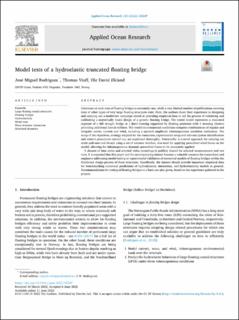| dc.contributor.author | Rodrigues, José Miguel | |
| dc.contributor.author | Hansen Viuff, Thomas | |
| dc.contributor.author | Økland, Ole David | |
| dc.date.accessioned | 2022-08-11T13:09:55Z | |
| dc.date.available | 2022-08-11T13:09:55Z | |
| dc.date.created | 2022-06-13T08:16:34Z | |
| dc.date.issued | 2022 | |
| dc.identifier.citation | Applied Ocean Research. 2022, 125 1-27. | en_US |
| dc.identifier.issn | 0141-1187 | |
| dc.identifier.uri | https://hdl.handle.net/11250/3011315 | |
| dc.description.abstract | Literature on tank tests of floating bridges is extremely rare, while a very limited number of publications covering tests of other types of very large floating structures exist. Here, the authors share their experience in designing and carrying out a model test campaign aimed at providing empirical data to aid the process of validating and calibrating a numerically based design of a generic floating bridge. The tested model represents a truncated segment of a full straight bridge at a fjord crossing supported by floating pontoons with 4 mooring clusters providing additional lateral stiffness. The tested environmental conditions comprise combinations of regular and irregular waves, current and wind, including a spectral amplitude inhomogeneous condition realization. The setup of the objectives, strategy adopted for the truncation, experimental setup and relevant system identification and control procedures carried out, are explained thoroughly. Noteworthy is a novel approach for carrying out static pull-outs and decays using a set of actuator winches, also used for applying prescribed wind forces on the model, allowing for inhomogeneous dynamic prescribed forces to be accurately applied. A dataset of time series and selected video recordings is publicly shared for selected measurements and test runs. It is expected that this paper and the accompanying dataset become a valuable resource for researchers and engineers addressing model testing or experimental validation of numerical models of floating bridges within the functional design process of these structures. Specifically, the dataset should provide important empirical data for benchmarking numerical predictions of hydrodynamic interaction, and hydroelasticity models in general. Recommendations for testing of floating bridges in a basin are also given, based on the experience gathered in the project. | en_US |
| dc.language.iso | eng | en_US |
| dc.publisher | Elsevier | en_US |
| dc.rights | Navngivelse 4.0 Internasjonal | * |
| dc.rights.uri | http://creativecommons.org/licenses/by/4.0/deed.no | * |
| dc.subject | Structural dynamics | en_US |
| dc.subject | Wave structure interaction | en_US |
| dc.subject | Model tests | en_US |
| dc.subject | Hydroelasticity | en_US |
| dc.subject | Floating bridges | en_US |
| dc.subject | Large floating coastal structures | en_US |
| dc.title | Model tests of a hydroelastic truncated floating bridge | en_US |
| dc.title.alternative | Model tests of a hydroelastic truncated floating bridge | en_US |
| dc.type | Peer reviewed | en_US |
| dc.type | Journal article | en_US |
| dc.description.version | publishedVersion | en_US |
| dc.rights.holder | Copyright: 2022 The Authors. Published by Elsevier Ltd | en_US |
| dc.source.pagenumber | 1-27 | en_US |
| dc.source.volume | 125 | en_US |
| dc.source.journal | Applied Ocean Research | en_US |
| dc.identifier.doi | 10.1016/j.apor.2022.103247 | |
| dc.identifier.cristin | 2031225 | |
| dc.relation.project | Norges forskningsråd: 268403 | en_US |
| dc.source.articlenumber | 103247 | en_US |
| cristin.ispublished | true | |
| cristin.fulltext | original | |
| cristin.qualitycode | 1 | |

